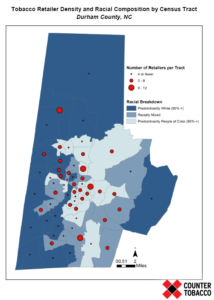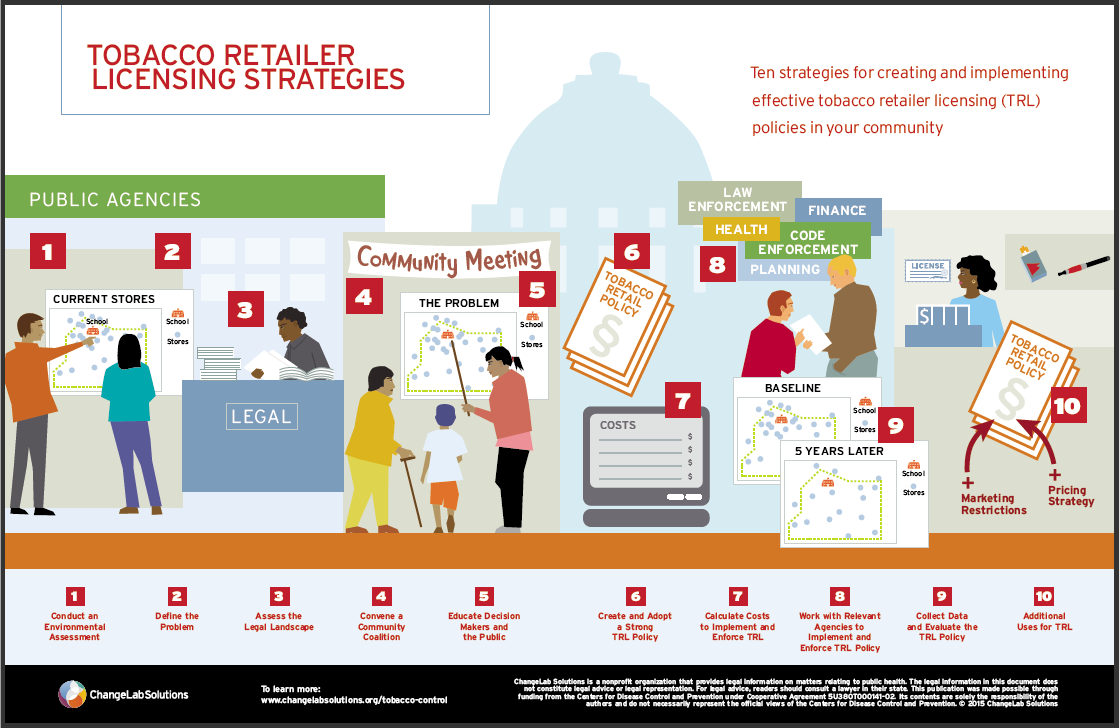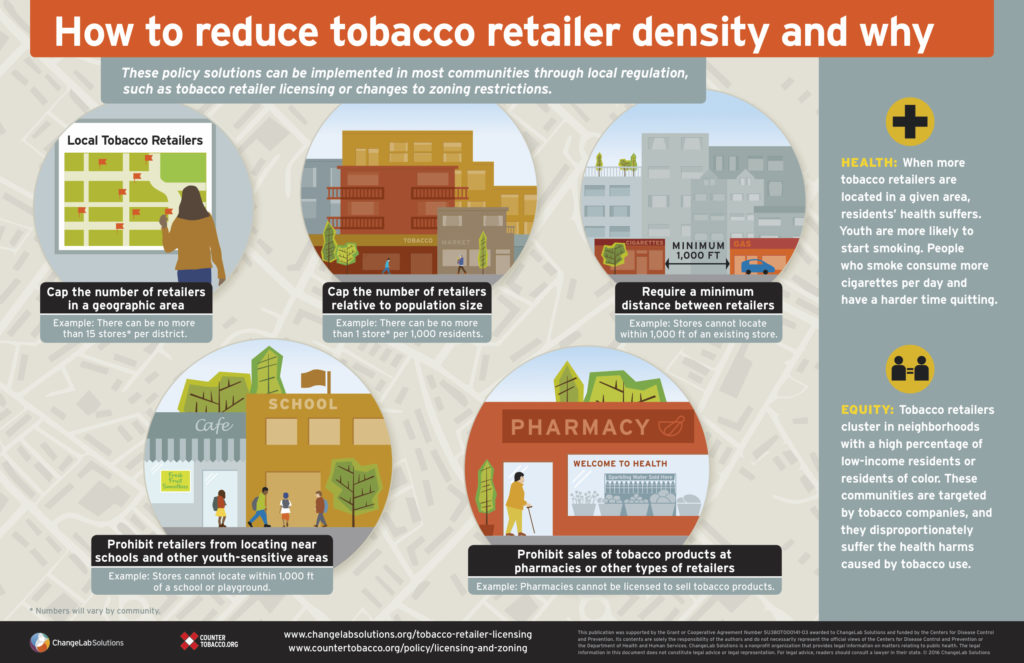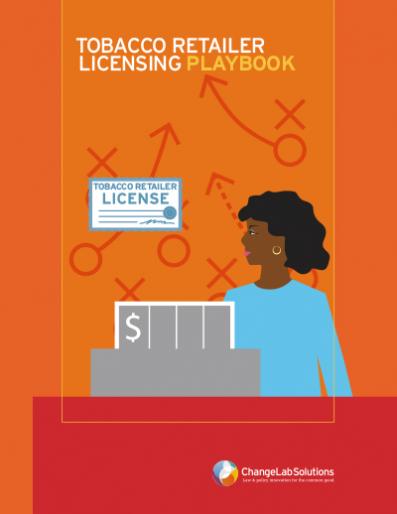Licensing, Zoning, and Retailer Density
Licensing and zoning are two of the most lasting strategies to impact the density of tobacco retailers, the types of retailers that can sell tobacco, and the location of tobacco retailers.
In general, licensing laws require that businesses obtain a license to operate a certain type of business, whereas zoning regulates how land can be used. Read more on the differences between licensing and zoning. Both strategies can be used to restrict the density, type, and location of tobacco retailers. This matters because retail availability of tobacco: 
- Perpetuates social norms about tobacco use. The ubiquitous presence of tobacco retailers gives the impression that tobacco is available and accessible.
- Increases exposure to industry point of sale advertising, marketing and promotions. The tobacco industry channels most of its marketing dollars into the retail environment (Read More).
- Reduces search costs for tobacco products. Proximity to tobacco retailers is associated with higher smoking rates[1] and can reduce the success of quit attempts for people looking to curb their tobacco use.[2, 3]
- Contributes to social and environmental inequities. Tobacco retail outlet density is higher in low income and minority neighborhoods, fueling disparities in tobacco use and its associated health effects.[4, 5, 6] Read Tobacco Retail Licensing Policy: A Health Equity Impact Assessment for more on how licensing can help improve health equity in communities.
- Contributes to higher smoking rates. Tobacco retail outlet density is associated with high rates of youth [4,5, 8, 9] and adult tobacco use,[1, 10] as well as higher rates of tobacco use initiation among youth and young adults. [11, 12] Recent evidence also shows that higher tobacco retailer density is associated with higher rates of smoking among pregnant women.[17] Additional evidence suggests that adolescents that live in neighborhoods with a greater density of tobacco retailers are significantly more likely to initiate use of alternative tobacco products such as cigars, hookah, and smokeless tobacco. [18]
- Increases perceived availability and accessibility of tobacco products, especially among youth.[2] Research has found that stores where youth are more likely to shop contain up to twice as much shelf space dedicated to the three brands most popular among youth.[3]
- Increases brand recognition, especially among youth,[2] which increases odds of smoking.[4]
- Encourages impulse purchases of tobacco products, cues cravings, and undermines quit attempts. [5, 6, 7]
See the infographic below on how to restrict tobacco retailer density and why (click to enlarge, or access the Spanish language version) then check out the companion factsheet from ChangeLab Solutions, “Tobacco Retailer Density: Place-Based Strategies to Advance Health and Equity.” Learn more about licensing and zoning strategies below.
Retailer density reduction strategies will have different impacts in different communities, depending on demographics and urbanity. See “Tobacco Licensing Laws: Improving Equity” from Ohio State University for a closer look at which strategy might help advance health equity in your community.
What is Licensing?
Certain types of businesses are required to purchase government-issued retail licenses that grant license-holding businesses permission to sell certain products under certain conditions. Generally, tobacco retail licensing (TRL) at the local level requires that the city or county issue businesses, new and existing, a license before they are allowed to sell tobacco products. As of June 2022, 40 states require a license for over-the-counter tobacco sales. For additional information on state-level TRLs, see:
- CDC STATE System Licensure Fact Sheet
- American Heart Association’s Tobacco Retail Licensure interactive map
- University of Maryland Legal Resource Center’s 50 State Survey of Tobacco Licensing Requirements
To find strategies for developing, implementing, and enforcing a comprehensive TRL policy, as well as local-level examples, review ChangeLab Solution’s Tobacco Retailer Licensing Playbook.
The evidence for implementing or strengthening TRL policies
Tobacco retail licensing is an evidence-based way to reduce tobacco use, and it can be used an effective way to substantially reduce the density, type, and location of tobacco retailers.[7] In doing so, TRL policies can help reduce disparities in how tobacco products are marketed and sold across different communities (Read more). It is a versatile regulatory platform that can be used to:
- Maintain a list of tobacco and e-cigarette retailers. Licensing enables the governing body to maintain a current and comprehensive list of businesses that sell tobacco. Organizations can use this data to map tobacco retailers and monitor the number, location, and density of retailers in their community. As of December 2022, 38 states plus the District of Columbia, the Northern Mariana Islands, and the U.S. Virgin Islands require a license to sell e-cigarettes or e-liquid over the counter.
- Fund compliance monitoring programs. Most TRLs include a yearly fee, which generates revenue to help the city or county cover the costs of inspection and enforcement of minimum age laws, tax laws, and compliance with the Family Smoking Prevention and Tobacco Control Act. Most TRLs include stipulations that require adherence to all tobacco laws. Raising the cost of an existing license fee can help ensure that monitoring and enforcement costs are sufficiently covered.
- Reduce sales to youth. Evidence also shows that strong tobacco retailer licensing laws can help reduce sales to underage youth. Across 33 California communities, sales to underage youth dropped by an average of 26% after implementation of a strong tobacco retailer licensing law. In Minnesota, a study found that daily smoking among young adolescents dropped by 28% in 14 communities that implemented comprehensive tobacco retailer licensing ordinances, and successful youth purchases dropped form 39% to 5%. [16]
- Prevent youth tobacco use initiation. Strong local tobacco retailer licensing laws can also help prevent youth tobacco use initiation for both cigarettes and e-cigarettes. In California localities that had a strong tobacco retailer license, youth were 33% less likely to have initiated cigarette use and 26% less likely to initiate e-cigarette use over the course of 1.5 years compared to localities that had no licensing law or did not have a licensing fee high enough to cover the costs of enforcement.[17] Another study found that in Pennsylvania, youth e-cigarette use dropped significantly following the implementation of licensing for e-cigarette retailers.[19]
- Reduce the density or clustering of retailers by restricting how close to each other tobacco retailers can be located. Tobacco retail outlet density is associated with high rates of youth [4,5, 8, 9] and adult tobacco use,[1, 10] as well as higher rates of tobacco use initiation among youth and young adults. [11, 12]
- Reduce the total number of retailers by setting moratoriums on the number of new licenses or capping the number of licenses (e.g., based on population or geographic area)
- When used together, capping the total number of licenses and setting a minimum distance that new tobacco retailers must be from existing retailers can help reduce the disproportionate density of outlets in disadvantaged neighborhoods.
- Case Study: Reducing Tobacco Retailer Density in San Francisco
- Case Study: Reducing Retailer Density in Philadelphia
- Another benefit of tobacco retailer licensing programs is the ability to allow license suspension and revocation. Strong TRL policies allow for the suspension and/or revocation of a store’s license for violating tobacco laws (including youth access laws). This can reduce the total number of retailers and reduce density. It also increases the likelihood that retailers will adhere to regulations, with a greater consequence than a fine, which some retailers may view as the cost of doing business.
- When used together, capping the total number of licenses and setting a minimum distance that new tobacco retailers must be from existing retailers can help reduce the disproportionate density of outlets in disadvantaged neighborhoods.
- Restrict businesses located near schools or youth-oriented facilities from selling tobacco. For example, communities have used licensing policies to restrict tobacco retailers within 1000 feet of schools. Studies show that high school smoking prevalence is associated with tobacco retail density near schools [13] and stores near schools have greater exterior tobacco advertising.[14 ] Research in Missouri and New York has shown that prohibiting tobacco retailers near schools would nearly eliminate income- and race-based disparities in retailer density between neighborhoods. [15] Read more about tobacco retailers near schools.
- Prohibit distribution of licenses in residential zones to help limit tobacco retailers in areas frequented by youth. Research shows that when there are more retailers in adolescents’ home neighborhoods, they are more likely to initiate tobacco use. [12]
- Restrict the types of businesses that can sell tobacco. Many communities have restricted the types of businesses, such as pharmacies, that can obtain TRLs.
- Address a variety of additional tobacco control strategies. By including plug-ins for more comprehensive tobacco control, tobacco retail licensing ordinances can include language to address strategies such as:
- Minimum pack size and minimum floor price regulations
- Tobacco product sampling restrictions
- Restricting the sale of flavored tobacco products
- Banning the redemption of tobacco discounts, coupons, and promotions
- Raising the minimum legal sales age to 21
- …and more
Licensing Case Studies:
- Alachua County, FL: Leading the Way in the Southeast on Tobacco Retailer Licensing, CounterTobacco.org
- Multnomah County, OR: No More in Multnomah: Youth Call for an End to Illegal Tobacco Sales, Multnomah County Health Department and ChangeLab Solutions
- Edgewater, CO: Retailer Licensing in Edgewater, Colorado, CounterTobacco.org
- Kern County, CA: Kern County’s Tobacco Retailer Licensing Program, Public Health Law Center
- Golden Valley, MN: Using Local Data to Pass Policies for Tobacco Prevention in Golden Valley, MN, CounterTobacco.org
- Philadelphia, PA: Reducing Retailer Density in Philadelphia, CounterTobacco.org
- Hayward, CA: Leveraging the community voice and equity issues to strengthen tobacco retailer licensing policy in Hayward, California Tobacco Endgame Center for Organizing and Engagement
- Colton, CA: Community campaigns to reduce youth access to tobacco products in Colton, CA, California Tobacco Endgame Center for Organizing and Engagement
- Santa Maria, CA: Santa Maria’s Tobacco Retailer Licensing Program, Public Health Law Center
A retailer licensing policy can help a community monitor and manage the number of tobacco retailers and is a typical policy lever pulled by towns or cities to manage the number of alcohol retailers. In December 2014, San Francisco passed a landmark tobacco retailer licensing law called the Tobacco Sales Reduction Act, which sets a cap on the number of tobacco sales permits allowed in each of the city’s 11 districts, aiming to reduce disparities in retailers density in lower income and minority communities. For more details on the city’s strategy and lessons learned, review Reducing Tobacco Retail Density in San Francisco: A Case Study. Watch this video from the youth of San Francisco’s Tobacco Use Reduction Force (TURF) to learn more about the law and why it is so important.
In 2008, San Francisco became the first city in the U.S. to ban tobacco sales in pharmacies. In February 2014, CVS announced its decision to stop selling tobacco products, becoming the first retail pharmacy chain in the U.S. to take such action. In Massachusetts over 80 cities and towns have enacted similar bans as of February 2014. Learn more about Massachusetts’ success in ‘Regulating Pharmacy Tobacco Sales: Massachusetts,‘ the second case study in the Innovative Point-of-Sale Policies series from the Center for Public Health Systems Science at Washington University in St. Louis. Learn more about Tobacco Free Pharmacies.
In April 2016, the Washington state legislature adopted rules to create a statewide licensing system for businesses that sell and distribute “vapor products,” including liquid nicotine. The state estimates that approximately 6,000 retailers will be affected by the new licensing rules, along with roughly 150 “vapor products” distributors. The rules, which are expected to take effect in fall 2016, require retailers to obtain a separate license to sell “vapor products” online. In addition, many local communities have adopted their own licensing and permit requirements for e-cigarette retailers and vape shops. For example, San Marcos, California, recently passed an ordinance requiring any shop that sells tobacco products, including e-cigarettes and related devices, to purchase a city-issued “tobacco retail license.” The city partnered with the San Marcos Prevention Coalition and the Vista Community Clinic, which conducted surveys of local e-cigarette retailers and vape shops and determined that a number of businesses were selling these products to minors in violation of state law. San Marcos plans to use the tobacco license fees (roughly $190 per establishment) to ensure that businesses are complying with tobacco control regulations, including restrictions on selling to underage users. Read more.
What is Zoning?
Most local governments use zoning for land use planning. By dividing areas into zones, local jurisdictions can control the types of businesses allowed to operate in certain zones. Zones might be designated as residential, commercial, industrial, agricultural, or mixed-use. Zoning laws can enable local regulators to keep similar land uses together, and keep incompatible land uses separated. For example, a residential zone might prohibit tobacco, alcohol, and firearm retailers.
When writing ordinances, you and your team of legal experts can tailor provisions of zoning and land use laws by adding Conditional Use Permits (CUPs), which allow certain land uses (e.g., tobacco retailing) only upon agreement of special provisions. For example, you could specify that tobacco can only be sold in certain zones if retailers agree to more stringent conditions or regulations, such as not selling flavored other tobacco products (OTPs). CUPs also give local governments the ability to make decisions about whether businesses can be allowed to operate on a case-by-case basis.
Why enact zoning regulations?
Like tobacco retailer licensing, zoning is an effective way to reduce the density, type and location of tobacco retailers. Zoning and conditional use permits can be used to:
- Prevent tobacco retailers from operating in certain zones (e.g., residential zones) or limiting them to certain zones (e.g., industrial zones). For example, in January 2017, Buffalo, NY overhauled their city’s zoning code and restricted new retailers from selling tobacco, hookah, alcohol, and vaping products in residential zones.
- Limit the number or density of tobacco retailers in certain zones. For example, “cap and winnow” strategies reduce the number of tobacco retailers over time through attrition
- Independence, MO has included provisions in their Unified Development Ordinance (UDO) that limits the number of tobacco stores and convenience stores without fuel sales to one per 15,000 residents, which over time will halve the number in existence at the time of the ordinance’s enactment. The UDO also prohibits any new tobacco stores from locating within 500 ft of a residential district, school, church, or public park.
- Restrict tobacco retailers from operating in certain areas (e.g., near youth-oriented facilities) through conditional use permits.
Best Practices for Getting Started
- Decide whether licensing or zoning strategies are best for your community. The first step is deciding whether to pursue licensing or zoning, so it’s important to determine policy goals and examine existing regulations. Review ChangeLab Solutions’ Licensing and Zoning: Tools for Public Health and Public Health Law Center’s Using Licensing and Zoning to Regulate Tobacco Retailers to learn more about the difference between licensing and zoning. For example, only licensing can be used as a mechanism for continued enforcement of tobacco control policies, while zoning policies might be used as part of a comprehensive effort to make neighborhoods healthier.
- Be sure to consult legal experts. The content on this site and associated resources are no substitute for actual legal advice.
- Find out if your state has tobacco retail licensing so you know whether you will be implementing a new policy or strengthening an existing one
- Research existing land use regulations in your community and find out whether your community allows zoning ordinances.
- Conduct an environmental assessment to define the problem
- Collect local data in your community. Collecting data on tobacco retailer location and creating maps to illustrate the problem of tobacco retail outlet density can be a powerful tool for engaging stakeholders. You can use Counter Tobacco’s “Tobacco Retailer Nation” Youth Engagement Activity to get started
- Conduct public opinion surveys to measure community support.
- Plan for equitable enforcement. Learn more in “Decriminalizing Commercial Tobacco: Addressing Systemic Racism in the Enforcement of Commercial Tobacco Control“
- Assess the legal landscape and consult legal experts.
Review the following resources:
- From the CDC Office on Smoking and Health: Summary of Scientific Evidence: Tobacco Retail Density, Location, and Licensure
- From the Public Health Law Center:
- Location, Location, Location: Regulating Tobacco & E-Cig Retailer Locations for Public Health – Tips & Tools“
- “Comprehensive Tobacco Retailer Licensing Ordinance“
- Tobacco Retail License Fee Calculator – Determine an appropriate fee that adequately supports the costs associated with implementing and enforcing a TRL system
- Webinar: Comprehensive Plans, Zoning, and the Intersection with Tobacco Regulation
- From the Public Health and Tobacco Policy Center
- From the Preventing Tobacco Addiction Foundation:
- A Guide to Best Practices in TRL: “Tobacco Retail Licensing: An Essential Tool to Reduce Youth Usage and Foster Health Equity”
- Tobacco Retail License (TRL) Model Components Checklist
- From ChangeLab Solutions:
- Tobacco Retailer Density: Place-Based Strategies to Advance Health and Equity
- Show Me Your License: The Basics of Tobacco Retailer Licensing
- Tobacco Retailer Licensing: An Effective Tool for Public Health
- Tobacco Retailer Licensing Playbook – find a strategy that works for your community.
- Model licensing ordinance and checklist
- “Plug-ins” – Licensing can be used to do more than just restrict the location and density of retailers. Think about what “plug-ins” to include in a licensing ordinance.
- Case studies Find lessons learned from communities in California that have effectively changed their licensing ordinances.
- Budgeting for a Local Tobacco Retailer License Fee – Learn how to assess the costs of a licensing program. Licensing fees can and should be used to fund monitoring and enforcement of the ordinance. The fee of an existing license can be raised to help cover monitoring and enforcement. Further, a recent study found that raising licensing fees can decrease the number of licenses renewed or purchased, reducing the number or density of retailers. [10]
- Model Land Use Ordinance and land use ordinance checklist

- Consider a media campaign. For an example, see the North Carolina licensing campaign posters
For an effective licensing or zoning policy, the Public Health Law Center recommends that the following policy elements be included:
| Policy Element | Explanation |
| Clear definitions and concise language | As with any law, tobacco control laws must be worded clearly and concisely. Carefully avoid vague or ambiguous language |
| Well-crafted implementation process | Licensing and zoning laws should specify the means by which a retailer applies for, receives and maintains permission to sell tobacco products. These provisions can include the type of forms to be filed, deadlines and fees for filing, and the ramifications of any failure to meet such requirements. |
| Robust enforcement options | The law should clearly describe the type of conduct it prohibits. Laws can require compliance with any and all federal, state and local laws that apply to the retailer, or could more narrowly require compliance with certain aspects of tobacco control laws, such as prohibitions against sales to minors, taxation statutes, promotional restrictions, and the like. |
| Reasonable penalty and appeals process | The law should explain the penalties for each violation of the law. For instance, penalties could include a graduated system of warnings and fines. Further penalties for certain violations could result in the suspension or revocation of the ability to sell tobacco products. Additional provisions could explain how penalties can be appealed. |
Table compiled using information from a Public Health Law Center guide to Using Licensing and Zoning to Regulate Retailers. For more detailed information, example policies, and other helpful legal resources regarding licensing and zoning ordinances, visit the Public Health Law Center website. In addition, be sure consult your legal experts, as the content on these websites is no substitute for legal advice.





